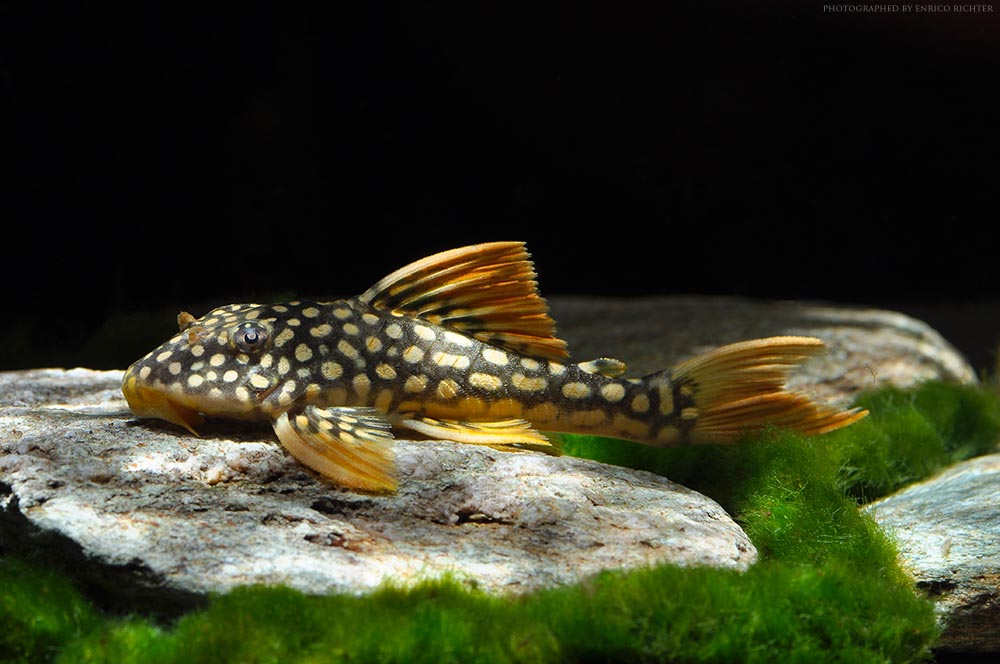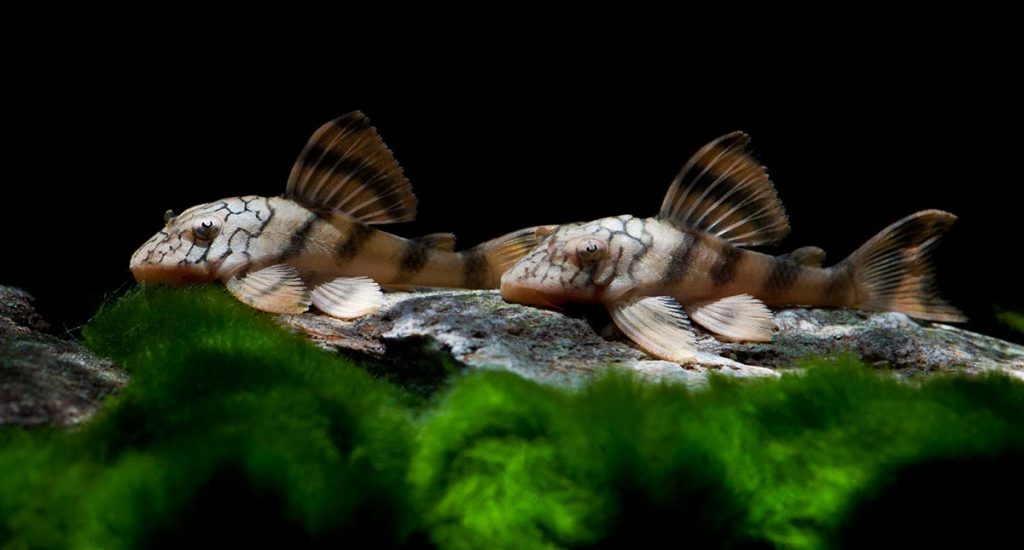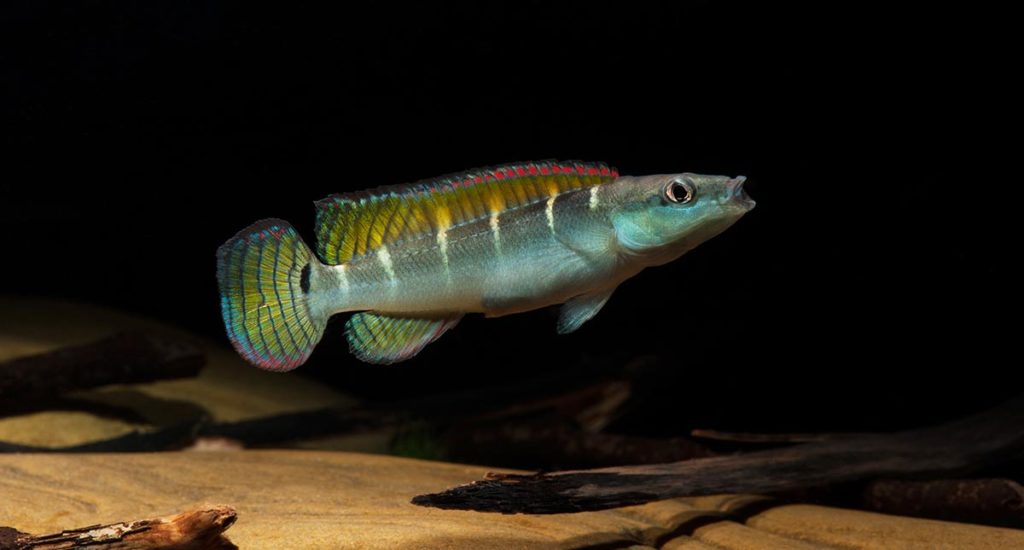by Stephan M. Tanner, PhD, and Dr. Leandro Melo de Sousa*, with images by Enrico Richter
*Universidade Federal do Pará, Altamira Campus, Pará, Brazil
The decade is still young, but while the world is embroiled in the COVID-19 crisis, there are sun rays at the horizon, to be exact the fish horizon, at least as far as aquarium fish enthusiasts are concerned.
Without great fanfare Brazilian authorities published a new directive rule (Instrução Normativa) on April 17, 2020 that establishes norms, criteria, and standards for the sustainable use of native fishes from continental, marine, and estuarine waters for aquarium hobby purposes effective May 1, 2020.

Scobinancistrus aureatus (L14) is a red-listed species that will continue to enter the aquarium trade with special export permission.
The updated rules will fundamentally change aquarium fish exports from Brazil going forward and are anticipated to greatly expand the diversity of species legally available to aquarium hobbyists around the globe.

Peckoltia braueri is widespread in the Brazil-Guyana region (L121), from the Rio Demini, Brazil (L135), and the Rio Takutu near Lethem, Guyana (L305).
The new Brazilian rule can be viewed online. An English translation has been included here and is also available as a PDF download for saving and printing.
AMAZONAS Magazine will provide in-depth coverage of this rule, and how it will change the aquarium trade and Brazil’s aquarium exports, in the forthcoming July/August 2020 issue which will become available in early June. Be sure to subscribe or renew so you don’t miss this exciting discussion.
OFFICIAL GAZETTE OF THE UNION
Published: 04/2020 | Issue: 75 | Section: 1 | Page: 5
*Translation by Stephan M. Tanner, PhD, Editor AMAZONAS Magazine, USA, and Dr. Leandro Melo de Sousa, Universidade Federal do Pará, Altamira Campus, Pará, Brazil
*Disclaimer: This translation does not constitute a legal document and is for informational purposes only. The translators accept no liability for its content and have no regulatory authority.
Organ: Ministry of Agriculture, Livestock and Supply / Secretary of Aquaculture and Fisheries
NORMATIVE INSTRUCTION (DIRECTIVE RULE) NO. 10, OF 17 APRIL 2020
Establishes within the Ministry of Agriculture, Livestock and Supply norms, criteria, and standards for the sustainable use of native fish from continental, marine, and estuarine waters for ornamental and aquarium hobby purposes.
The AQUACULTURE AND FISHING SECRETARY OF THE MINISTRY OF AGRICULTURE, LIVESTOCK AND SUPPLY (Portuguese Acronym MAPA), in the use of the attributions granted by MAPA Ordinance No. 812, of January 25, 2019 and Article 29 of Annex I of Decree No. 10. 253, of February 20, 2020, in view of the provisions of Law No. 13.844, of June 18, 2019, MPA Normative Instruction No. 04, of February 4, 2015, amended by MAPA Normative Instruction No. 4, of February 28, 2019, which is set out in Process No. 21000.030767/2019-51, resolves:
Art. 1 The Ministry of Agriculture, Livestock and Supply establishes norms, criteria and standards for the sustainable use of native fish from continental, marine, and estuarine waters for ornamental and aquarium hobby purposes, in accordance with the provisions of this Normative Instruction.
Single paragraph. The provisions of this Normative Instruction shall not apply in the following cases:
I – presentation of live fish for food consumption; and
II – exhibitions of live fish in public and private aquariums, zoos, shows or similar for didactic, educational, or scientific purposes.
CHAPTER I
PRELIMINARY PROVISIONS
Art. 2 For the purpose of this Normative Instruction, it is considered:
I – Ornamental: to use living or nonliving aquatic organisms for decorative, illustrative, or aesthetic purposes;
II – Aquarium hobby: to maintain or sell, for leisure or entertainment purposes, living individuals in aquariums, tanks, lakes or reservoirs intended for this purpose; and
III – Exploitation: act of removing, extracting or collecting a natural resource, for purposes of economic exploitation.
CHAPTER II
CAPTURE AND EXPLOITATION
Art. 3 It is allowed to capture, transport and market live specimens of fish native to continental, marine, and estuarine waters, except:
I – species included in Official Lists of Endangered Species of Fauna – Fish and Aquatic Invertebrates
II – species listed in the Appendices to the International Convention on Trade in Endangered Species of Wild Fauna and Flora (CITES);
III – when the species in question has specific characteristics that require planning measures with regard to its use, to be defined by means of technical expert opinions endorsed by the Scientific Society, covering the taxon in question; and
IV – specimens collected on oceanic islands, for marine, and estuarine species.
Single paragraph. Live specimens native or exotic from continental, marine, and estuarine waters produced by cultivation, may be marketed for ornamental and aquarium hobby purposes, provided that the establishment is duly registered with the competent agency.
Art. 4 Live specimens of native species included in an official list of endangered species, as long as having specific regulation or authorization issued by the competent environmental agency that allows the use for such purposes, may be used for ornamental and aquarium hobby purposes.
Art. 5 The exploitation for ornamental and aquarium hobby purposes of species not scientifically described will be conditioned on the existence of reference samples, according to the registration number at the Museum, University or Research Institute, where they are deposited in recognized scientific collections and with databases available on online platforms of the Brazilian Biodiversity Information System – SiBBr.
Single paragraph. The prohibited species for ornamental and aquarium hobby purposes will be constantly updated and made available through the website of the Secretariat of Aquaculture and Fisheries of the Ministry of Agriculture, Livestock and Supply – SAP/MAPA.
Art. 6 During the process of capture of native fish from continental, marine, and estuarine waters for ornamental and aquarium hobby purposes, the following practices will not be allowed:
I – use of chemical substances, anesthetics, toxic agents or such causing irritation;
II – actions that cause damage to the natural habitat of species or aquatic fauna;
III – actions that cause physical damage to corals, mollusks, echinoderms, crustaceans, sponges, algae, and other beings belonging to the marine substrate; and
IV – perforation of the swim bladder of the specimen for decompression.
Art. 7 For capture of fish native to continental waters, marine, and estuarine, for ornamental and aquarium hobby purposes, the following fishing gear, procedures, and equipment are allowed:
I – for specimens of species native to continental waters, the following fishing gear and procedures:
gill nets;
encircling nets (seines);
fish traps;
cast nets;
dip nets;
non-perforating rods to dislodge the fish from their burrows or shelters;
manual collecting with snorkel; and
manual collecting with scuba gear or air compressor.
II – for specimens of species native to marine and estuarine waters, the following fishing gear and procedures:
(a) cast nets: small size 2 (two) meters in diameter and mesh of 1 (one) centimeter, and large size up to 3 (three) meters in diameter and mesh of 3 (three) centimeters;
(b) dip nets;
(c) non-perforating rods to dislodge fish from their burrows or shelters; and
(d) manual collecting with scuba gear or air compressor.
III – For specimens of native continental, marine, and estuarine species, the following equipment and forms of packaging on board are allowed/required:
a) Reservoirs with constant renewal of water for maintenance of the captured specimens;
b) Small net tanks, containers and plastic bags with holes, intended for packaging the fish during the collection of specimens;
c) Plastic containers of various sizes, with holes, used for the confinement of individual specimens;
d) Hunting traps or sticks;
e) Dive belts;
f) Swim fins;
g) Dive masks;
h) Dive regulators (stages I and II) for artificial respiration; and
i) Air cylinders and compressors for artificial respiration.
Single paragraph. Other fishing gear or equipment may be used if authorized by the competent department.
Art. 8 Vessels used in the capture of marine and estuarine fish for ornamental and aquarium hobby purposes must be registered and have a valid permit issued by the competent organ.
§1 The crew of the vessels referred to in the heading of this article may catch marine and estuarine fish in a maximum quantity of 5 kg (five kilograms) of fish plus 1 (one) specimen per trip and per fisherman, only if destined exclusively for their own consumption.
§2 Vessels authorized to fish for marine and estuarine fish for ornamental and aquarium hobby purposes shall not carry fishing gear and equipment in disagreement with the provisions of this Normative Instruction, except line and hook for the purpose of catching the fish referred to in §1 of this article.
CHAPTER III
TRANSPORTATION
Art. 9 The transport of fish species from continental, marine, and estuarine waters throughout its route must be accompanied by electronic invoice as proof of origin, transit, and destination of specimens of living aquatic organisms for ornamental and aquarium hobby purposes throughout the national territory.
§1 The Electronic Invoice shall contain the number of the General Record of Fishing Activity – RGP of the issuer, in the categories of Professional Fisherman, Fishing Company, or Aquaculture.
§2 In the Federation Units where the Electronic Invoice system is not implemented or operating, the merchant shall issue a paper invoice, which shall be accompanied by a copy of the valid General Record of Fishing Activity of the issuer.
Art. 10 For the transportation of living aquatic organisms for ornamental and aquarium hobby purposes, the issuance of the Animal Transit Guide – GTA is waived in the following cases:
I – when the transport includes the stretch between the place of fishing and the first point of marketing, and the catch must be made by a Professional Fisherman registered in the General Record of Fishing Activity – RGP; and
II – when the transport includes the stretch between a trader and the final consumer, and the latter does not carry out fishing activities for commercial purposes of the body (s) in question.
Art. 11 The packages for transporting fish from continental, marine, and estuarine waters for ornamental and aquarium hobby purposes must present in their external area, in a visible way, identification containing box number, Electronic Invoice number or License, Permit, Certificate or other Export Documents – LCPO, scientific name and number of specimens of each species.
§1 Packages containing fish specimens for ornamental and aquarium hobby purposes must mandatorily allow the visualization of the animals for inspection purposes, except in the case of external packages, such as cardboard or Styrofoam boxes.
§2 The Electronic Invoice and LCPO shall contain the scientific name of the species or registration number at the Museum, University or Research Institute.
Art. 12 For species of continental, marine and estuarine aquatic organisms effectively traded, the following variations will be tolerated, as long as they do not include specimens of any prohibited species.
§1 Variations of up to 15% will be tolerated between the amount of fish declared and that actually transported in boxes containing more than 500 animals of the same species, and 10% for boxes containing between 100 and 500 animals of the same species.
§2 Variations of up to 15% between the species of fish declared and that actually transported shall be tolerated for boxes containing more than 500 animals of the same species, and 10% for boxes containing between 100 and 500 animals of the same species.
CHAPTER IV
FINAL PROVISIONS
Art. 13 Articles 1, 2, 3, 4, 7, 8, 9, 10, 11, 12 and 13 and Annexes I and V of IBAMA Normative Instruction No. 202, of 22 October 2008, are hereby revoked.
Art. 14 Articles 1, 2, 3, 4, 5, 6, 10, 11, 12, 13 and 14 and Annexes I and II of MPA/MMA Normative Instruction No. 01 of January 3, 2012 are hereby revoked.
Art. 15 MPA Normative Instruction No. 21 of September 11, 2014 is hereby revoked.
Art. 16 The penalties and sanctions provided for in Law No. 9605 of February 12, 1998 and its regulations shall apply to violators of this Normative Instruction.
Art. 17 This Normative Instruction shall come into force on May 1, 2020.
JORGE SEIF JUNIOR







That Bolsonaro is going to ruin Brasil… Let the exploitation begin.
Do you know of a Brazilian fish market that will ship Amazonia fish for consumption to the USA? I can take orders 300 lbs and above weekly.
We are a Travel Agency, many of our clients are from Brazil, have been asking if they can order Tambaqui, Pacu, Payara, etc.
Hi Lephus, I am sorry, I don’t know any food fish exporters in Brazil that ship to the US.